EthidiumBromide
Harmless

Posts: 42
Registered: 27-9-2020
Member Is Offline
Mood: Effervescent
|
|
What are some interesting uses for lithium metal
I have about 100 g of Li metal and I was wondering on some interesting ways to utilize some of it.
Of course you can always throw some into water, but that's just not as exciting as sodium or potassium. I already tried burning it, which was pretty
cool. But I'm more interested in productive ways to use it.
I already have distillation of cesium metal from CsCl and Li on my list of things I would like to do, as soon as I muster the financial bravery to
purchase some CsCl. I also want to try dissolving Li in anhydrous ammonia (don't know if I have anything suitable to try the birch reduction, though).
Are there any other interesting applications/reactions for Li metal that can be done in a home lab?
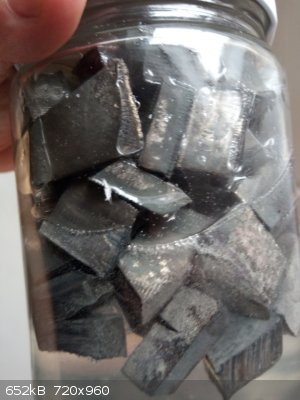
|
|
|
Antigua
Hazard to Others
  
Posts: 155
Registered: 27-9-2020
Member Is Offline
|
|
If you've got access to any subzero temperatures you could do some LEGAL Birch reductions, it's a very beautiful and elegant use of Li.
|
|
|
Ubya
International Hazard
    
Posts: 1231
Registered: 23-11-2017
Location: Rome-Italy
Member Is Offline
Mood: I'm a maddo scientisto!!!
|
|
if i remember correctly there was a old post of someone succesfully making lithium hydride from lithium metal and hydrogen gas. You could use lithium
hydride as is or experiment and try to make lithium aluminium hydride, a super useful reducing agent
---------------------------------------------------------------------
feel free to correct my grammar, or any mistakes i make
---------------------------------------------------------------------
|
|
|
HydrogenSulphate
Harmless

Posts: 38
Registered: 13-10-2019
Member Is Offline
Mood: Caffeinated
|
|
You could synthesise n-butyl lithium by reaction of the Li metal with 1-bromobutane or 1-chlorobutane. You'll need an inert atmosphere, as n-butyl
lithium is pyrophoric 
|
|
|
MidLifeChemist
Hazard to Others
  
Posts: 192
Registered: 4-7-2019
Location: West Coast USA
Member Is Offline
Mood: precipitatory
|
|
Simple ideas would be reacting Lithium with sulfur or a halogen, especially bromine or iodine. Alternatively, you could see if there is way you could
use it to reduce Calcium or Strontium to their elemental forms.
|
|
|
Bedlasky
International Hazard
    
Posts: 1219
Registered: 15-4-2019
Location: Period 5, group 6
Member Is Offline
Mood: Volatile
|
|
You can burn it in nitrogen atmosphere to make lithium nitride.
You can also make lithium carbide from lithium and acetylene, look at this.
|
|
|
EthidiumBromide
Harmless

Posts: 42
Registered: 27-9-2020
Member Is Offline
Mood: Effervescent
|
|
Thank you for your suggestions!
Quote: Originally posted by Antigua  | | If you've got access to any subzero temperatures you could do some LEGAL Birch reductions, it's a very beautiful and elegant use of Li.
|
Yes, I admit the Birch reduction is a very appealing way to use Li. But I'm afraid I don't have anything specific I'd like to reduce, so if I decide
to give it a go I'll end up using some random substrate with an aromatic ring, like benzoic acid or toluene, for the sake of the reaction alone.
Quote: Originally posted by Ubya  | | if i remember correctly there was a old post of someone succesfully making lithium hydride from lithium metal and hydrogen gas. You could use lithium
hydride as is or experiment and try to make lithium aluminium hydride, a super useful reducing agent |
This also seems interesting. It's not easy to get LiH or LAH, none of my domestic vendors have it. LAH is of course a very useful reagent, so it might
be worth the effort.
Quote: Originally posted by HydrogenSulphate  | You could synthesise n-butyl lithium by reaction of the Li metal with 1-bromobutane or 1-chlorobutane. You'll need an inert atmosphere, as n-butyl
lithium is pyrophoric  |
I don't think I'm well equipped to handle pyrophoric liquids, unfortunately. But n-BuLi is definitely a very interesting and useful compound.
Quote: Originally posted by MidLifeChemist  | Simple ideas would be reacting Lithium with sulfur or a halogen, especially bromine or iodine. Alternatively, you could see if there is way you could
use it to reduce Calcium or Strontium to their elemental forms.
|
I already did reactions of Li (and Na, K) with S, I2 and red P. Very vigorous reactions, and with potassium, even explosive! But using lithium to
reduce other metals is certainly worth trying.
Quote: Originally posted by Bedlasky  | You can burn it in nitrogen atmosphere to make lithium nitride.
You can also make lithium carbide from lithium and acetylene, look at this. |
I'll also consider making these lithium compounds (Li3N is particularly interesting), thanks!
|
|
|
woelen
Super Administrator
        
Posts: 7976
Registered: 20-8-2005
Location: Netherlands
Member Is Offline
Mood: interested
|
|
A very interesting experiment is adding lithium to pure ethylenediamine. This allows you to see solvated electrons. You get Li(+) ions and free
electrons, both of which are solvated by the ethylenediamine. The solvated lithium ions are colorless, but the e(en) complex is deep blue.
https://woelen.homescience.net/science/chem/exps/electride/
[Edited on 2-11-20 by woelen]
|
|
|
EthidiumBromide
Harmless

Posts: 42
Registered: 27-9-2020
Member Is Offline
Mood: Effervescent
|
|
^ Thanks for informing me of this! I do remember reading that some amines are capable of generating solvated electrons with alkali metals, similar to
ammonia. But I wasn't aware that ethylenediamine could do this. I have rather easy access to it, so that means I won't need the cold temperatures
required for condensing ammonia (my only way to accomplish this would be using dry ice and acetone or ethanol, sadly I can't get it locally and need
order it online, with rather expensive shipping).
Good to know that I don't need anhydrous NH3 to observe solvated electrons. I will have to try this ASAP.
[Edited on 2-11-2020 by EthidiumBromide]
|
|
|
Bedlasky
International Hazard
    
Posts: 1219
Registered: 15-4-2019
Location: Period 5, group 6
Member Is Offline
Mood: Volatile
|
|
Woelen: That's really cool! I didn't know that some amines can solvate electrons. I wonder if diethylenetriamine can solvate electrons. I have few
mils of dien and I plan to buy few grams of potassium for some fun demonstrations, so I'll try it.
How did I missed this experiment? I discovered few articles of yours on this forum and when I wanted to return to them, I couldn't found them (so I
must searched them on SM). Do I something wrong? I browser on your site through periodic table. And when I click on Li, I cannot find this article.
|
|
|
j_sum1
Administrator
       
Posts: 6218
Registered: 4-10-2014
Location: Unmoved
Member Is Offline
Mood: Organised
|
|
Distillation of Cs and Rb springs to mind.
|
|
|
karlos³
International Hazard
    
Posts: 1520
Registered: 10-1-2011
Location: yes!
Member Is Offline
Mood: oxazolidinic 8)
|
|
Ethylenediamine is a good start, but how about lithium acetylide ethylenediamine complex?
You can safely do acetylidations with it.
Check the Beumer paper from 63 for some more informations, it looks feasible to me.
|
|
|
woelen
Super Administrator
        
Posts: 7976
Registered: 20-8-2005
Location: Netherlands
Member Is Offline
Mood: interested
|
|
My fault. I forgot to add an index to that page. This weekend
I'll fix that.
|
|
|
Cou
National Hazard
   
Posts: 958
Registered: 16-5-2013
Member Is Offline
Mood: Mad Scientist
|
|
Has anyone ever made organolithiums at home? I daydream about a day when I'm experienced enough in home organic chemistry to invest in a schlenk line
and start playing around with organolithiums.
[Edited on 11-6-2020 by Cou]
|
|
|
EthidiumBromide
Harmless

Posts: 42
Registered: 27-9-2020
Member Is Offline
Mood: Effervescent
|
|
I tried the experiment of Li metal in 99% ethylenediamine.
My sample was slightly yellow, probably due to some oxidation of the ethylenediamine sample. Nonetheless, the experiment worked perfectly. I cut up
the lithium into approximately 2 mm sized pieces to get a faster reaction. Below is the sequence of changes during the course of the experiment.
About 3 minutes after adding Li:
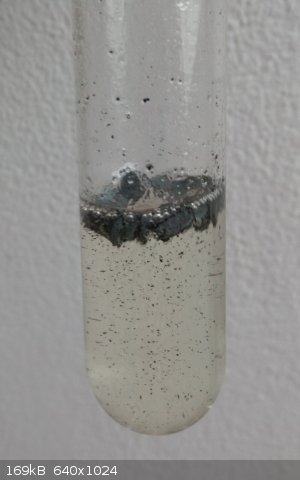
About 10 min after adding Li:
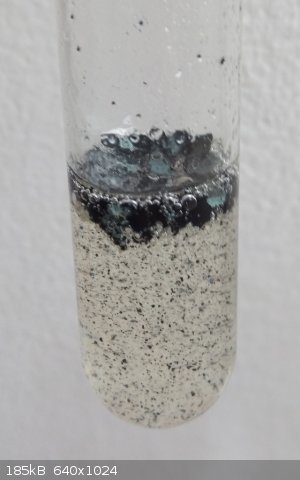
What I found most interesting was that the solvated electrons came off in "bursts" from the surface of the lithium into the ethylenediamine, rather
than just slowly and gradually dissolve into it like it happens in general with colored compounds dissolving into solvents.
After 15 min of adding Li, I swirled the test tube a bit. The first few swirls of blue immediately vanished, but after the 5th or 6th, the deep blue
color remained for longer:
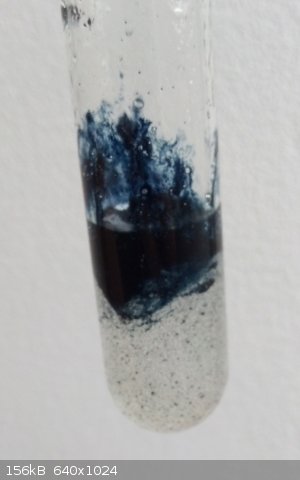
After a 3 more swirls, almost the whole contents of the test tube maintained the blue color:
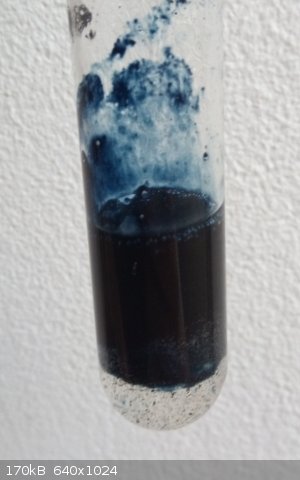
Finally, after 20 minutes the entire test tube was filled with the dark blue color. I held it up with the roof window as the background.
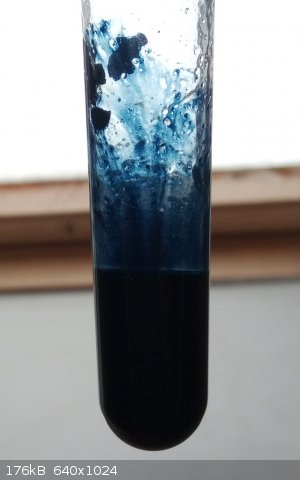
I'm satisfied with the outcome. I'm still amazed that it's possible to observe solvated electrons without using sub-zero temperatures in order to
liquify ammonia. So, thanks again for sharing this experiment, Woelen. I can get solvated electrons off my list of things to do (though I still want
to try the Birch reduction eventually)
|
|
|